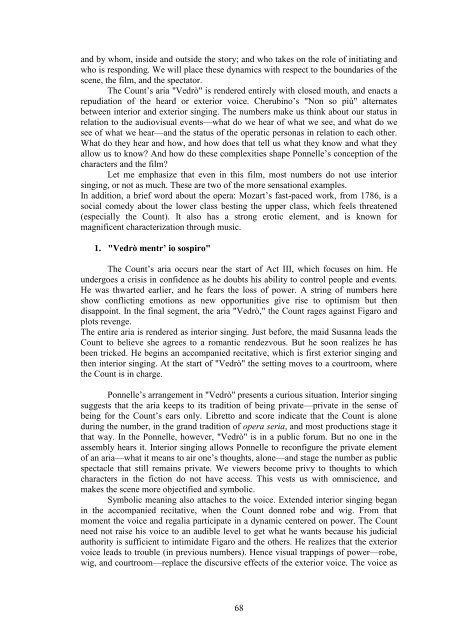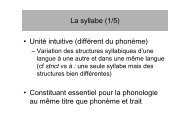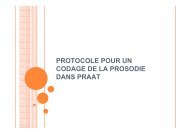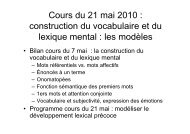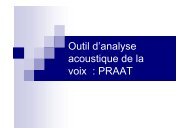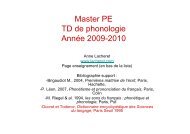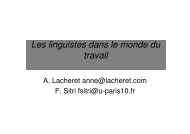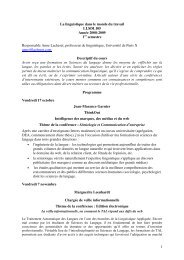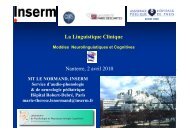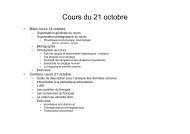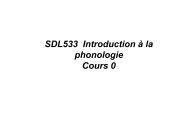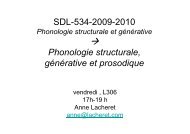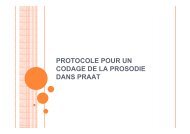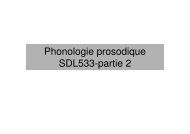You also want an ePaper? Increase the reach of your titles
YUMPU automatically turns print PDFs into web optimized ePapers that Google loves.
and by whom, inside and outside the story; and who takes on the role of initiating and<br />
who is responding. We will place these dynamics with respect to the boundaries of the<br />
scene, the film, and the spectator.<br />
The Count’s aria "Vedrò" is rendered entirely with closed mouth, and enacts a<br />
repudiation of the heard or exterior voice. Cherubino’s "Non so più" alternates<br />
between interior and exterior singing. The numbers make us think about our status in<br />
relation to the audiovisual events—what do we hear of what we see, and what do we<br />
see of what we hear—and the status of the operatic personas in relation to each other.<br />
What do they hear and how, and how does that tell us what they know and what they<br />
allow us to know? And how do these complexities shape Ponnelle’s conception of the<br />
characters and the film?<br />
Let me emphasize that even in this film, most numbers do not use interior<br />
singing, or not as much. These are two of the more sensational examples.<br />
In addition, a brief word about the opera: Mozart’s fast-paced work, from 1786, is a<br />
social comedy about the lower class besting the upper class, which feels threatened<br />
(especially the Count). It also has a strong erotic element, and is known for<br />
magnificent characterization through music.<br />
1. "Vedrò mentr’ io sospiro"<br />
The Count’s aria occurs near the start of Act III, which focuses on him. He<br />
undergoes a crisis in confidence as he doubts his ability to control people and events.<br />
He was thwarted earlier, and he fears the loss of power. A string of numbers here<br />
show conflicting emotions as new opportunities give rise to optimism but then<br />
disappoint. In the final segment, the aria "Vedrò," the Count rages against Figaro and<br />
plots revenge.<br />
The entire aria is rendered as interior singing. Just before, the maid Susanna leads the<br />
Count to believe she agrees to a romantic rendezvous. But he soon realizes he has<br />
been tricked. He begins an accompanied recitative, which is first exterior singing and<br />
then interior singing. At the start of "Vedrò" the setting moves to a courtroom, where<br />
the Count is in charge.<br />
Ponnelle’s arrangement in "Vedrò" presents a curious situation. Interior singing<br />
suggests that the aria keeps to its tradition of being private—private in the sense of<br />
being for the Count’s ears only. Libretto and score indicate that the Count is alone<br />
during the number, in the grand tradition of opera seria, and most productions stage it<br />
that way. In the Ponnelle, however, "Vedrò" is in a public forum. But no one in the<br />
assembly hears it. Interior singing allows Ponnelle to reconfigure the private element<br />
of an aria—what it means to air one’s thoughts, alone—and stage the number as public<br />
spectacle that still remains private. We viewers become privy to thoughts to which<br />
characters in the fiction do not have access. This vests us with omniscience, and<br />
makes the scene more objectified and symbolic.<br />
Symbolic meaning also attaches to the voice. Extended interior singing began<br />
in the accompanied recitative, when the Count donned robe and wig. From that<br />
moment the voice and regalia participate in a dynamic centered on power. The Count<br />
need not raise his voice to an audible level to get what he wants because his judicial<br />
authority is sufficient to intimidate Figaro and the others. He realizes that the exterior<br />
voice leads to trouble (in previous numbers). Hence visual trappings of power—robe,<br />
wig, and courtroom—replace the discursive effects of the exterior voice. The voice as<br />
68


